“Windy, windy!” I remarked for what seemed the upteenth time this month. Early May has had a lot of wind, nearly every day, from the northwest. This is due to a big high pressure system parked offshore of Vancouver Island, creating gradients with the low pressure over inland BC and Washington. It’s also meant nice weather – sunny and hot.
I can’t remember the last time it’s rained. Although it’s probably only been 2 weeks, that’s a long time to go without rain in the Pacific Northwest spring. Our boat became more and more salt encrusted as we bashed upwind to Campbell River.
In Campbell River we did a significant boat repair project (more on that later), and provisioned for our circumnavigation of Vancouver Island, which will take us through July. With 2-3 months till our next big grocery store, we bought even more stuff than we did in March in Seattle! After a tiring three days of boat work and chores, we were ready to move on to Johnstone.

Sunrise from Otter Cove at 6am
Johnstone Strait Strategy
I’ve written about our Johnstone Strait strategy before. Johnstone typically has strong winds from the northwest, which combined with an outgoing ebb current (the favorable current you want when going north) can make for miserable upwind conditions. Southeasterly pressure, for a downwind run and wind aligned with current, is rare but not as rare as some may think. It simply requires patience and timing.
This year we lucked out and only had to wait a day or two – in Gowland Harbor and Otter Cove. Although in reality it could be said we waited two weeks – there’s been at least two weeks of gale force northwesterlies in Johnstone – but during that time we were slowing down our sail north, visiting places we like to go anyway (Desolation Sound, etc).
On Sunday May 12 we had the forecast we needed – the ECMWF model was predicting southeasterly flow in the Strait of Georgia and Discovery Passage on Sunday afternoon, followed by SE 5-15 in Johnstone on Monday, and SE 5-20 in Johnstone on Tuesday. The Canadian forecast only agreed with Tuesday’s ECMWF prediction, but the ECMWF has far greater granularity and prediction accuracy.

The GPS on one of our Asus tablets has been freezing and glitching out sometimes lately. We definitely were not sailing at 18 knots into land! Navionics recommended an app called GPS Status and Toolbox which I’m trying out to hopefully fix it.
Otter Cove
We started our Johnstone Strait transit from Otter Cove, a small anchorage just south of Chatham Point. The day before we had departed from Gowland Harbor and passed though Seymour Narrows about 50 minutes after slack (neap tide, only 3 kts current going with us). We had a slow sail into N 4-7, and then it changed to SE 10-15 – perfect!
Otter Cove is a place we’ve been meaning to check out for a while. It’s a little exposed, but was a good anchorage – quiet and calm overnight. It does get slightly bumpy when tugs pass by, or in light SE wind, but not too bad.
Loss of the Fanny Island Wind Station
The Fanny Island wind station has been down for at least a month. It’s “temporary”, but with government who knows how long it will be down. I emailed Environment Canada and actually got a response! They said the station’s batteries get depleted when there isn’t enough solar energy to charge them up in the winter months. They’re planning to work on it in May or June.
The solar explanation didn’t really make sense to me because there’s been tons of solar energy in the last two weeks – long days of sun with our panels putting out summer-time-like power. Clearly the Fanny Island batteries are simply dead / improperly maintained.
This is a big deal though because Fanny is the only automated wind reporting station in Johnstone Strait. Without this data boaters are basically “flying blind” when entering the strait, having to trust only the forecasts (which aren’t always accurate). Fanny provided hourly, near-real-time data of what the strait is doing.
The Chatham Point lighthouse also provides wind and wave data, but only every 3 hours, not digitally measured (less precision), and is stationed at a location that is a lagging indicator for northwest wind. Chatham is at the eastern end of the strait, while Fanny Island is in the middle and receives the highest winds typically. It was something we relied on a lot to know what the strait is doing, and with it down until June, boaters could have a bit harder time in Johnstone.
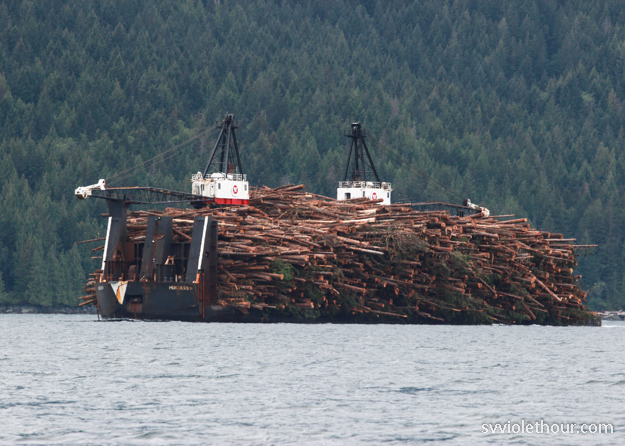
A big log barge under tow eastbound in Johnstone
Otter Cove to Mary Island (Tuna Point)
Monday morning we waited in Otter Cove for the southeast wind to start (about 11:30), which was fine because the favorable current didn’t start till 12:30. For the first hour we had about SE 8-12 and then it picked up to SE 16-20. We tried a few different downwind sail configs, including wing-and-wing with the genoa on the whisker pole. That was kind of hard to get set right – we’ll have to work on it some more.
Surprisingly, two powerboats, on separate occasions today, were rather inconsiderate and passed us very closely doing over 10 knots, sending a big wake at our beam. The second powerboat was a 60 footer actually doing 20 knots (in displacement / partial planing mode pushing a lot of water) and passed only 300 feet away. We had to turn up into his container-ship-sized wake. I guess some boaters really don’t want to deviate slightly from their point-to-point course.

The eastern half of Johnstone can be amazingly flat when the wind is running with current.
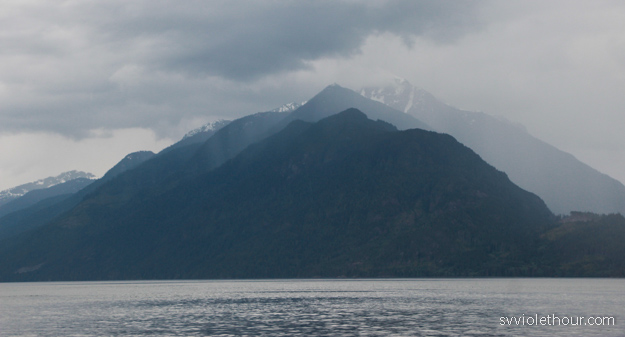
Dark clouds over the mountains – rain moving in. Southeasterly wind often means rain and clouds, but it’s a price worth paying for a downwind run.
As we exited Current Passage and approached Fanny Island (with the broken wind station!), I could see the wind and weather had changed big time up ahead. There were big white caps west of Sunderland channel and that likely meant wind against current. Our southeasterly luck had run out and the wind had switched to west 20 kts in the western half of the strait. We quickly reefed down and switched from downwind mode to upwind.

This is why we prefer to sail Johnstone downwind! (photo upwind in 20 with 2 kts current against wind, west of Fanny Island)
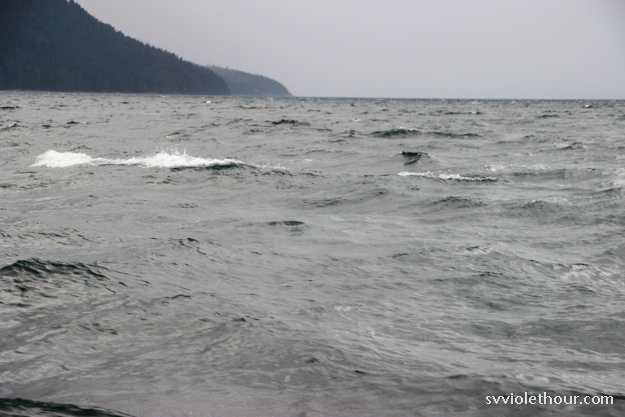
Our time window on the ebb was running out anyway, so there was little point in trying for further (Port Neville) so we pulled into Mary Island, east of the islets. This proved to be a good spot, protected from the wave fetch that was making its way into the western cove. (And surprisingly, there’s Internet here)
Tuna Point to Growler Cove
The next day we waited a bit again for the southeasterly to start, and for the unfavorable flood current to die down. The wind began about 11am so we actually headed out 2-3 hours prior to the ebb, but found the flood wasn’t nearly as strong as expected and only slowed us down by half a knot or so.
The wind picked up to E 15-22 and we had a fun, fast sail, doing 7 knots at times. We reefed and unreefed several times. Eventually the wind died near the end of the strait and we headed to Growler Cove. Two cruise ships emerged from Blackney Passage while we were sitting in the middle of Johnstone doing only 2 knots (3-4 kts of wind).
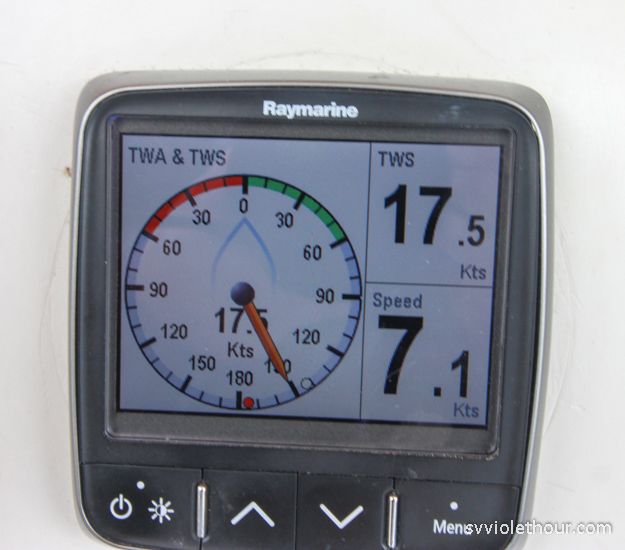
Volendam actually hailed us on the VHF to let us know his intended course. It’s quite rare for commercial traffic to hail sailboats, so I was pretty excited to hear from a cruise ship captain.
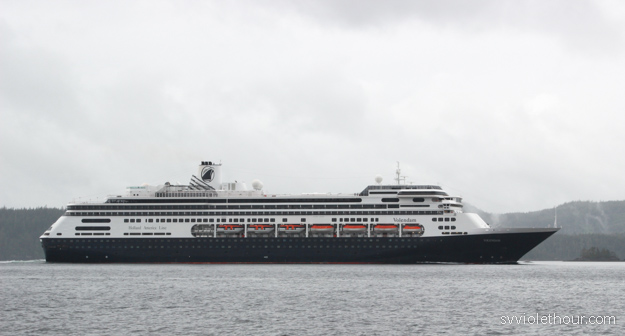
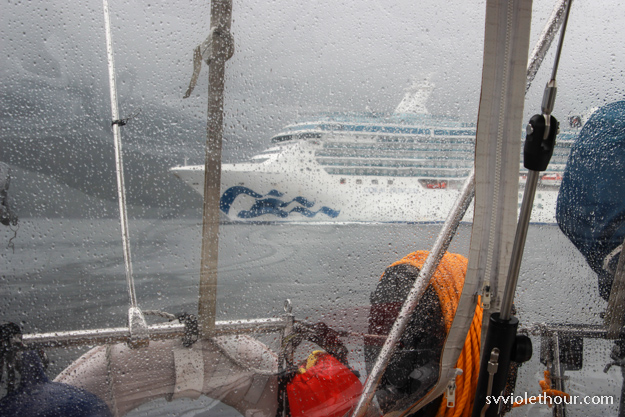
Cruise ship taking our stern! We could hear the movie playing on the pool deck, but not well enough to figure out which movie it was.
Growler Cove was empty but for us – of the three or so times we’ve been there it’s always been empty or had just one other boat. I don’t quite understand it because it’s quiet, pretty, and well protected.
Pearce Islands, Cormorant Marine Park
After Growler Cove we sailed over (well, 2/3 sailed, 1/3 motored) to the Pearce Islands. This is a spot we’d been wanting to visit for a while, but never had the chance. We were also slightly deterred by cruising reports that say high currents can flow through the anchorage – even driving kelp and logs onto your anchor chain.
However the reward is a beautiful, calm setting with tons of wildlife. Looking to my left I watched as a few eagles flew overhead, and looking to my right I could see two seals on the rocks. The female seal (we presume) was a white/grey speckled one and basking in the sun. The male (again, just guessing) was black and periodically switched between swimming around and shimmying back onto the rocks. It was funny to watch him struggle to get back out sometimes – a few attempts to get onto the rocks failed but eventually he succeeded.
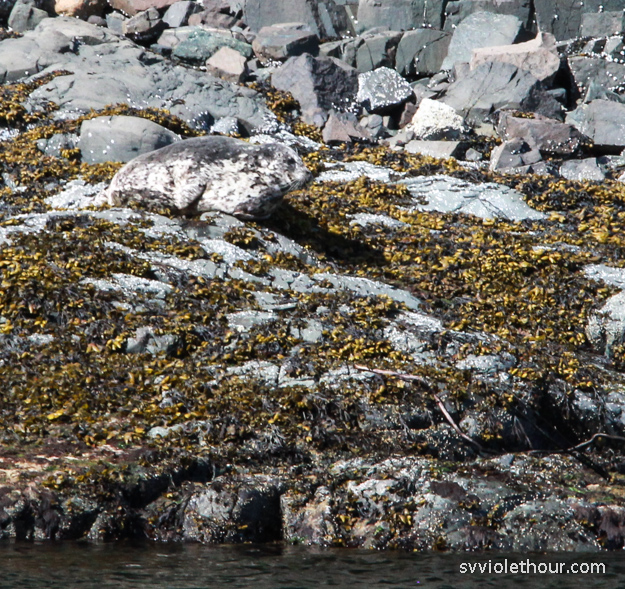
We did have about 1-2 knots of current moving the boat around, but it was no problem – nothing like the awful 3+ knot current we experienced once in Port Neville that sent vibrating harmonics through our anchor snubber and rushing water under the hull all night long.

Coming Up
The weather pattern has changed dramatically from early May – from sunny, warm and northwesterly winds to cloudy, rainy and occasional southeasterlies. This is exactly what we expected for May, and will hopefully provide some nice SE wind for sailing north. We’ll be heading to Port McNeill for provisions in a few days, and then sailing up Queen Charlotte Strait to round Cape Caution to the Central Coast.
With our passage through Johnstone we’ve also reflected on how dramatically our cruising will change because of passing that gate. North of Johnstone we see fewer boats, much less civilization, and more remote, untouched wilderness. We look forward to the beauty of this coastline, while also hoping a few more sailors would join us up here in the early season.

Wow fabulous! I’ve been on the Volendam too! Crossed the Tasman Sea on her.
It’s now September and Fanny Island is STILL out of commission! So is Sentry Shoal- the only in-water weather buoy at the northern end of Georgia Strait. They’ve both been dead since spring, and mariners should be raising hell with the Coast Guard over their shoddy maintenance, and lack of concern for maritime safety.
Yikes. I emailed Env Canada again to check in on Fanny and Sentry Shoal, and here’s their response: “The Fanny Island station sends reports occasionally, but there is a problem with the communication equipment at the station. The Sentry Shoal buoy stopped transmitting on June 29 and it looks like water infiltration caused a power failure. Both the Fanny Island station and Sentry Shoal buoy will be repaired during the next maintenance visit, but the date hasn’t been determined yet.”
If anyone else would like to email them to express concern (maybe if they hear how many mariners it impacts the buoys might get fixed faster?), the address I’ve used is: ec.ecweather-meteo.ec@canada.ca